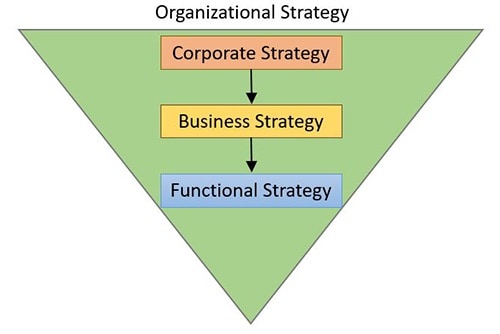Corporate Level Strategy: What It Is Plus 9 Examples
Success in business is not a random occurrence. It’s the result of planning, p...

If you’re looking for a way to bridge the gap between your more general corporate strategy and your hyper-specific functional strategy, create a business level strategy between the two.
What exactly is business level strategy? And how can you use it to achieve the success you’re looking for? The answer to those questions can be found by examining the three types of business strategy side-by-side.
In This Article, We Talk About:
Think of your business as a car or truck. The engine provides the power. The wheels and tires move the vehicle. But if you tried to connect the two systems directly, the car wouldn’t go. To make it all work, you need a third system.
Business strategy is very similar. Here’s how it all fits together.

Business level strategy (or just business strategy for short) is a component of a much larger organizational strategy that provides direction for all your company’s activities.
Going back to the vehicle analogy, organizational strategy is the car or truck as a whole with a driver behind the wheel directing it where to go.
More specifically, these types of strategies specify how your company will allocate resources (e.g., money, labor, inventory, etc.) in order to support the various parts of your business (e.g., infrastructure, production, marketing, etc.).
You can see this illustrated in the image above by the green triangle that surrounds the other three strategies.
The triangle is positioned upside down because the further up the strategies you move, the broader and more all-encompassing the goals become. The further down the strategies you move, the more specific the goals become.

Corporate level strategy is like the engine in your car. It provides the power — the drive — to get your business where you want it to go.
Leaving the car analogy for a moment, most corporate level strategy is focused on one of three outcomes:
Because there are many ways to reach these general goals, corporate level strategy is, by nature, complex and uncertain, and it’s geared toward the long-term. Unfortunately, that type of strategy doesn’t translate well into specific, actionable items. For that, we need the next stage.
To help you understand business level strategy, let’s pick up the car analogy again.
The engine creates power. But it does so in only one direction. If you were standing by the rear bumper of your car (and you could see through to all the moving parts underneath), you would see a spinning shaft coming out of the engine (we’ll skip the transmission for simplicity’s sake). That shaft would be turning in a clockwise or counterclockwise direction.
But we don’t want to travel left or right, which is where we would go if we hooked the wheels directly to the driveshaft. We want to go forward. For that, we need a differential.

The differential takes the clockwise rotation of the driveshaft and transforms it into forward and backward rotation. That rotation, then, makes the wheels turn in the direction you want.
Business level strategy is like that differential. It translates the drive produced by the corporate level strategy into action (functional level strategy) that moves your business in the right direction.
Business level strategies are more focused than corporate level strategies, but not nearly as focused as functional level strategies. If, for example, your corporate level strategy was to increase market share, your business level strategy might be:
Once you’ve established your business level strategy, you’re ready to start moving toward your goals.

Functional level strategy is where the rubber meets the road, so to speak (like the tires in our car analogy). Functional level strategies are the specific actions and benchmarks assigned to departments (and individuals) that move your business toward the goals created by the corporate level strategy.
So if you set one of your business level strategies to improve the quality of your product (in response to the corporate level strategy of increasing market share), then a specific functional level strategy might be for your R&D department to redesign the product to make it cheaper to produce.
That strategy would then be broken down into smaller jobs and assigned to individuals who would do the actual work.

Business level strategies are put in place to ensure that all departments within your business are working toward the same corporate level strategy. Without this, it’s easy for one department to get off track and begin moving in a different direction than the rest of your organization.
Success is all about teamwork at every level of your business — between individuals, teams, departments, managers, and owners. Business level strategies are there to coordinate all these disparate elements and get them working toward the same goal.
When you establish your corporate level strategy, you don’t want your marketing department doing the job of your production department. They likely don’t have the skills necessary to do the job right.
Business level strategies provide direction to each department (and by extension, to each individual). Business level strategies, in large part, determine the specific capabilities and skills that each department will use to achieve its goals.
While direction is a big part of what business level strategies do, it’s not the only part.
Business strategies tell your team which way to move and what to work on, but they also tell them when to perform these activities by establishing priorities for the work.
Your business strategy may tell each department, each team, and each individual what they should do first, second, third (and so on) in order to keep your company as a whole moving in the right direction.
A strong business strategy can also help simplify the decision-making process. When your team has a direction and a set of priorities for when to tackle the work, the answers to the decisions you have to make may become more obvious.
For example, if your corporate strategy is to grow profits two percent by the end of the year but you’ve already reached market saturation, your choices are limited, and you may need to diversify.
With that decision in mind, you can then set your business strategy accordingly. The result of all that is that your team may have more of a clear and focused direction — find new markets for your product or service — and might not have to make a decision on that variable beforehand.
They can get right to work.
Adaptation in business is essential — be it for your company as a whole or for you and your employees individually.
Business level strategies may help streamline adaptation so that everyone involved (and your entire organization) can keep growing and improving.
Think of it this way: If you’re taking a bus to work and the bus breaks down five blocks from your destination, do you give up, turn around, and go home? Of course not. You wait for another bus, hail a cab, or walk the rest of the way.
Your business strategy is the destination. So if problems come up along the way, you’ll know how to adapt — find an alternative solution or even go back to the drawing board — in order to continue moving toward the ultimate goal.
In many ways, a strong business strategy can streamline adaptation by eliminating the many different ways you could go and revealing the options that will move you toward success.

Let’s say you’ve set your corporate level goal to increase market share. These examples of business level strategy tell you how your business is going to achieve that goal.
In this strategy, your company is trying to beat its competitor’s prices. That translates into:
Once you know your business level strategy (cut costs), you can start looking at your organization with an eye toward decreasing spending.

When you set differentiation as your business level strategy, you’re not concerned with price. Instead, you’re focused on setting your product or service apart from your competitors.
To that end, you may position your company as one with higher standards of quality. That translates to specific goals like improving production and reducing faulty products.
An integrated business level strategy combines the ideas of low cost and differentiation into one common goal. This strategy allows flexibility in both price and added value.
So, for example, you aim for the middle-of-the-road in terms of price but include an added component (higher quality, novel feature) that justifies the higher price.

When crafting your strategy, be sure that the goal you establish is measurable. For example, your strategy might be to improve a specific service you offer. That’s fine — it’s a good goal to have — but it’s not measurable.
You need to assign some type of quantitative value (a number) to the process that will indicate whether you’ve been successful or not.
Instead of just saying, “We want to improve the renewal rate of our service,” say, “We want to improve the renewal rate of our service by five percent.”
That five percent gives your team something to shoot for and also informs the choices they have to make in order to get there.
Being realistic is essential if you want your strategies to be successful. For example, you may set a goal to increase profits from $100,000 to $200,000 over the next fiscal year. But is that really realistic?
If you’re coming out with a whole new line of products and services, it may be. But if you’re just improving slightly on an existing product or service, it’s not likely that your profits will jump that much in a single year.
Instead, it may be better to set a more realistic strategy of increasing profits by 10 or 20 percent (to $110,000 or $120,000).
Along with making your goals measurable and realistic, craft your strategy to be as specific as possible. So, instead of stating that your company wants to be the best in the business, incorporate measurable and realistic tips into your thinking.
With those details in mind, you can craft a business level strategy that is both specific and achievable. In this case, that might be to hold a 75% market share among all direct competitors.

When rolling out new business strategies, momentum is key. If you leave your strategies open-ended, your team may lose the desire and drive to accomplish their goals.
You can attempt to counteract this loss of momentum by attaching a deadline to all the strategies and goals involved.
Doing so may also help provide structure and direction to help your team know what it needs to do first (and second and third). It can also tell them how quickly they’ll need to accomplish certain things in order to stay on track and complete the project before the deadline.
The success of all your strategies may depend on how well you coordinate those involved. Depending on the type and size of your business, this may mean individuals, teams, departments, locations, and even other businesses.
Ultimately, you want the various levels of your business working together to fulfill their part of the strategy.
And this doesn’t just apply to the frontline workers. It also applies to new hires, managers, owners, and everyone in-between.
While different individuals, teams, and departments may be working on separate tasks, they should all be working toward the same goal: achieving the business level strategy as a whole.
If some part of your business is pulling in a different direction, it might be much harder to accomplish what you set out to do. A business is very much like a team of horses. If they’re not all pulling in the same direction, very little gets done.
Be sure that everyone knows what they’re supposed to do and how it contributes to the overall goal and betterment of your business.
One of the keys to a successful business strategy is creating a clear separation of responsibilities.
You need to be sure that everyone knows who is responsible for the unique components of each goal, project, or task. That delineation could come at the individual level, the team level, or the department level.
Without a clear separation, you may find that work gets done twice or by those without the knowledge and skills to do it right.
When you understand business level strategy (and, indeed, all three levels of strategy) you may be able to:
In addition, incorporating business level strategies can give the managers in your business a better understanding of how their work (and the work of their teams) impacts your organization’s goals.
And when everyone is pulling together in the same direction, it will be much easier for your business to succeed.

One possible way to get everyone working together to accomplish the business level strategy is by implementing team management software, such as Sling.
The Sling suite of tools provides:
When you harness the power of the Sling app, you and your team have the potential to save countless hours each week that you can then dedicate to accomplishing all your business level strategy goals.
For more free resources to help you manage your business better, organize and schedule your team, and track and calculate labor costs, visit GetSling.com today.
See Here For Last Updated Dates: Link
This content is for informational purposes and is not intended as legal, tax, HR or any other professional advice. Please contact an attorney or other professional for specific advice.
Schedule faster, communicate better, get things done.